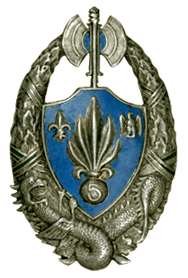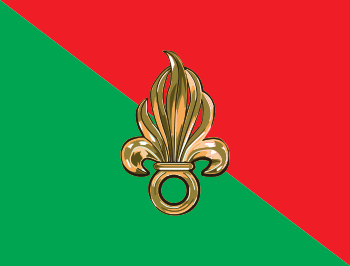5th Foreign Infantry Regiment
| 5th Foreign Infantry Regiment 5e Régiment Étranger d'Infanterie | |
|---|---|
|
Regimental insignia of 5e REI | |
| Active | 1930 – 2000 |
| Country |
|
| Allegiance | French Army |
| Branch |
|
| Type | Infantry- Engineer |
| Garrison/HQ | Numerous various |
| Nickname(s) | Régiment du Tonkin |
| Motto(s) | Le plus chic, le plus beau, le plus chouette (Fr) |
| Colors | Green & Red |
| March | Le front haut et l'âme fière |
| Engagements |
World War II Indochina War Algerian War |
| Battle honours |
|
| Insignia | |
| Insignia of the 5th Foreign Infantry Regiment |
 |
| Abbreviation | 5e REI |
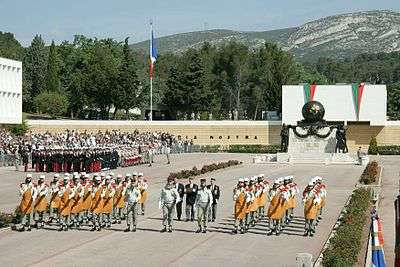
The 5th Foreign Infantry Regiment (French: 5e Régiment Étranger d'Infanterie, 5e REI), surnamed Régiment du Tonkin, was a regiment of the French Foreign Legion created under the Third Republic, and dissolved in 2000. The history of this regiment is marked by the participation to World War II and the conflicts of the Indochina and Algeria.
Creation and different nominations
- On September 1, 1930 : creation of the 5th Foreign Infantry Regiment 5e REI.
- On July 1, 1945 : almost disappeared, dissolved for the first time. Effects are regrouped at the corps of the Marching Battalion of the 5e REI (French: bataillon de marche du 5e REI).
- On November 1, 1949 : the regiment was reconstructed from elements of the 6th Foreign Infantry Regiment 6e REI and 4th Foreign Infantry Regiment 4e REI.
- On October 1, 1963 : the regiment became the 5th Mixed Pacific Regiment 5e RMP.
- July 1, 1984 : designated as 5th Foreign Regiment 5e RE.
- June 30, 2000 : within the cadre of the reorganization of the French military, the 5th Foreign Regiment 5e RE was dissolved. The regimental colors entered into the museum.
History
Indochina
Prior to the war
The imputable troubles to the decrease of consecutive effectifs of World War I underlined the necessity of reinforcing the troops in Tonkin. Four battalions of the French Foreign Legion were funneled to the Extrême-Orient and formed the 5e REI.
Heir to the units of the Legion that combated in Tonkin, since 1883, the regiment was created on July 17, 1930 and was put into effect on September 1, 1930.
The regiment was established from the 1st, 7th and 9th Battalions of the 1st Foreign Infantry Regiment that had been previously deployed to Indochina from 1920 to 1927.[1] Garrison duty in French Indochina proved to be a fairly comfortable assignment for the legionnaires until the outbreak of World War II with the notable exception of the Yên Bái mutiny in 1930.
Within the means of supply and materials, the regiment was maintained provisionally on the functioning of previous units forming the corps within the cadre of the ephemeral Demi-Brigade of the Foreign Legion (French: demi-brigade de Légion étrangère, DBLE) issued from the 1st Foreign Infantry Regiment.
The regiment wasn't really constituted until April 1, 1931. Colonel Debas, regimental commander of the DBLE, was designated as chef de corps.
- Headquarters staff, the company hors rang, the 10th company of the 3rd battalion and the 4th battalion garrisoned at Vietri
- the 1st battalion, the regimental music band and the transmission section garrisoned at Tong
- the 2nd battalion, at Dap Cau
- the 2nd company of the 3rd battalion at Tuyen Quang
- a section of the 2/5e REI, at Sept Pagodes
- a detachment of the 2/5e REI, at Phu Lang Thuong
- the 9th company of the 3/5e REI at Yen Bay where the muntiny of the same name took place
- special section garrisoned at Ha Giang
The regimental colors were received on May 7, 1932 at Son Tay. On September 7, 1932, the 4th battalion was dissolved. The regiment counted only three battalions. The units were regrouped at Hanoi.
In 1936, général Buhrer considered the enlargement of the regiment's field of action. The regiment prefigured the functions of « bâtisseur » du « 5 ». The command envisaged the possibility of exterior actions and anticipated two grands routes allowing the placement of strategic motorized manoeuvres based on the needs of the situation. The first linked Hai Phong to Phong Saly and the second the Tonkin to the south of Indochina.
The 5th Foreign Infantry Regiment 5e REI relayed the battalions in the execution of grand construction works out of which many strategic routes. The legionnaires worked and form instructed the locals to put in place and construct the delicate and required tasks.
World War II
- 1940 : The 2nd battalion of the 5e REI (commandant Marcelin) illustrated capabiltiy at Lang Son.
- 1941 : During the Franco-Thai War, the 3rd battalion mounted combats in Cambodia, near Battambang and the 1st battalion near Pailin.
- 1945 : the regiment mounted the defensive against the Japanese Army.
In 1939, the command post was garrisoned at Vietri. The 1st battalion was at Tong, the 2nd battalion and the motorized detachment was at Dap Cau, the 3rd battalion was at Tuyên Quang. In September, the declaration of war in Europe did not provoke any particular agitations. Nevertheless, anticipated dispositions in relation to general mobilization were taken into accords.
In 1940, the command post of the regiment, the 1st and 3rd battalions moved to Cambodia. The 2nd battalion assured a part of the garrison of Lang Son and Dap Cay, while the motorized detachment joined Cao Bang. Japanese forces eventually mounted the attack on Lang Son in 1940. On September 22, 1940 the 2nd Battalion of 5th Foreign Infantry Regiment was attacked by elements of the Japanese Army as they withdrew from China across the Tonkin border.[2] Accordingly, the 2nd battalion, in garrison at Fort Brière de l'Isle, mounted defensive measures under the impulsion of chef de battaillon Marcelin. A cease fire was then ordained.
The 2nd battalion participated with the DML to the pursuit of contingents that were terrorizing the populations. The effort was carried through until January 15, 1941. Accordingly, the fanion of the 2nd battalion was decorated with the Imperial Order of the Dragon of Annam. In 1941, the command post of the regiment went back to Việt Tri. The 1st battalion I/5e REI was at Tuyên Quang, the II/5e REI was at Tong, the III/5e REI at Sept-Pagodes and the motoryzed detachment at Lang Son.
Accordingly, territorial struggles followed with attacks along the Mekong and the western-frontier of Cambodia. The Siamese troops, very well armed, launched their efforts on January 16, 1941. A violent combat opposed the legionnaires at two battalions supported by tanks and aviation. In front the defensive resistance of the Régiment du Tonkin, the aggressors unfolded. The 3rd battalion endured over twenty killed and a dozen wounded. The armistice was signed end of January and accordingly territories were attached to Cambodia and Laos.
In 1945, the 5e REI held the garrisons of Viét Tri, Tong, Tien Kien, Lang Son and Hanoï, with other elements in the surrounding garrisons. The Japanese considerably reinforced within liaison means on the ensemble of the Indochinese territories, were equipped with modern arms. In 24 hours, they rendered themselves masters in their element of all the garrisons. At Ha Giang, Yen Bay, and Cao Bang, French forces disappeared. Certain elements were successful in joining the forces that were marching towards the frontier of China. The 9th company which was designated to guard the command post succeeded in filtering through. The last elements of the 5e REI reached the frontier of China. They joined Tsao Pa on May 2 after having hiked 1500 km in 93 days. On place, they benefited of the benevolence of général Pechkoff, former Legion officer and representative of France at Tchong King.
Marching battalion of the 5e REI, BM 5
On July 1, 1945, the regiment was dissolved. The remainder of the force were regrouped in a marching battalion BM 5, which the units of traditions kept the fanions of their battalion. In February 1946, the legionniares were authroized to cross the Tonkin frontier, to push the Viet Minh, their new adversary, approaching Son La. They were stopped by the accords of Hanoi. Linked to the exterior world only by radio and parachuting, they succeeded in June to reach the province of Sam Neua, which they protected against the pillards. On November 1, 1946, the BM 5 was dissolved. On December 12, 1946, the remainder embarked on the Sontay in direction to Algeria and the maison mère of Sidi bel-Abbès.
Indochina War
At the moment were the war in Indochina was developing, the 5e REI was set back on foot in Tonkin on November 1, 1949 from the V/4th Foreign Infantry Regiment and effectifs from Sidi bel-Abbès. On April 12, 1950, at Haiphong, lieutenant-colonel François Binoche received the regimental colors from général Alessandri, commander-in-chief of Tonkin. The new mission of the 5e REI was to defend the frontier north-east of Tonkin, and principally the axe route which linked the Mon Caï sector to the Delta.
Trials of small holding posts were exercised. On November 26, 1949, the 1st battalion was found engaged in combat in the RC6, where the post of Cho Bo and Hoa Binh were menaced and the post of Suyut was encircled. The legionnaires replied back on February 22, 1950 through an operation.
The 2nd battalion, was dispersed in small detachments on the principal posts of Tien Yen, Dam Ha, Ha Coi et Mon Caï. The unit along with the 3rd Foreign Infantry Regiment 3e REI participated to the disarmament of various contingents passing into Indochina. On April 16, 1950, an operation was launched, to which the 1st battalion participated with. This operation was followed by another, south of Hanoi. The Viet-minh pressure accentuated on the frontier with China. Following the attack of May 25, 1950 again Dong Khe, command sent the 2nd battalion to reinforce the status mission dispositif.
On September 16, rebels launch an offense in Cao Bang which fell. The posts of Na Cham and Dong Dand were evacuated under the protection of the battalion in rear-guard. The unit collected the debris of colonnes Charton and Lepage as well as the echeloned garrisons along the pressure axes of the Viet-minh (Battle of Route Coloniale 4).
The 1st battalion mounted the assault from Mon Caï side and retook position at Tan mai on October 20, 1950. Ten days later, the unit reoccupied Dinh Lap and saved la bande côtière. Facing the length of the disaster, the triomph was modest.
At the end of 1950, the regiment wa echeloned on the RC 18 and the frontier zone in the region of Mon Caï. In December, the GM 6 was created from elements of the regimental command company. The unit made way to meet the 174 Viet-Minh regiment which was marching on Dhin Lap. The harassment was continuous all along the column. The 2nd battalion endured 50 killed and 50 wounded. The last couple of days of this dreadful month were marked by the clearing operation of Binh Lieu led by the 1st battalion, which after having owed in front of the important means of the adversary, managed to recuperate the wounded and reoccupied the post for a couple of hours finding only three killed and two wounded.
At his arrival to Indochina, général Jean de Lattre de Tassigny decided to create a fortification belt around the Delta. Since the beginning of 1951, the 2nd battalion committed to the task and was joined by the 1st battalion already in works in the region of Vinh Yen and Vietri. Until the month of November, the life of the pioneers (French: Les Pionniers) followed, opening of routes, ambushes, harassment and regulated attacks.
The 3rd battalion was integrated into GM 4 within the cadre of an operation. The 1st battalion distinguished savoire faire during two other operations. Combats around the river developed. The III/5e REI, implanted in the sector was attacked in vain. The end of the year 1951 witnessed the end combats around the river where the Viet-Minh was panting. Nevertheless, the 304th division controlled the RC6 and hoped to make Hoa Binh a renewed version of Cao Bang.
The battle commenced in the night of January 7 and 8 1952 and the unfolding of Hoa Binh started on February 23, 1952. The I/5E REI joined Xuon may and the lines of cemented posts. The rebels were masters of the mountainous regions where they rested camps, armouries and depots. The troops of Tonkin were reduced to garrison in the Delta. The cement belt was not sufficient enough to prevent infiltrations. The « pourrissement » of the Delta developed. This first « reduction » would be, the fief of the Régiment du Tonkin until the end.
The 2nd battalion participated to the clearing of the sector of Phat Diem then to various operations. The 3rd battalion was signed at Na Sam in 1952. The legionnaires participated to six different operations. The war changed face. The means put in place by the adversary increased exponentially. The more the Viet-Minh gained grounds, the more the regiment had to multiply to extinguish the fires. The unit remained until April 6, 1953, organizing continuously positions, constructing and building roads to unserve the adversary, and enduring while repelling ongoing increasing attacks.
The 4th battalion constituted in big part of Vietnamese became the 75th Vietnamese Battalion. The month of July 1953 sees the GM 5, with the 2nd battalion, participating to the welcoming of paratroopers which illustrated themselves during an operation. In the Delta, operation followed on September 1953, then October 15 in the region of Phu Nho Quan and the sector of Dong Qui Thon as well as Trai Lai Vi.
In March 1954, the 5E REI was represented at Dien Bien Phu, by the 2nd Mixed Heavy Mortar Company 2e CMML and by 80 volunteer legionnaires to be parachuted « pour l’Honneur ».
During this time, the 1st battalion was transported on December 30, 1953 to Cochinchine, then Laos. Around Seno, the battalion led until May 12, 1954, a couter-guerilla warfare. On March 22 and March 23, the region of Ban Seng Phon was the theatre of an intense packed battle where the battalion endured the loss of 23 killed, 23 disappeared and 125 wounded. The intervention of the third battalion of the 1st Moroccan Tirailleurs Regiment III/1e RTM saved the battalion, in front of an adversary ten times in number and armament.
The regiment regrouped on May 12, 1954 while the retrenched camp of Dien Bien Phu was falling. On the other hand, on April 16, 1954, the GM 5, composed of the 2nd and 3rd battalion of the 5e REI, endured heavy losses against a battalion at Thai Binh. Following, the Régiment du Tonkin applied the accords of the armistice and handed Hanoi to the Viet-Minh.
On October 10, 1954, the last element crossed the bridge. The regiment regrouped then in Annam where the unit remained for 7 months. The regiment was dedicated to peaceful works, constructing of camps and routes. In September 1955, the 5th Foreign Infantry Regiment celebrated the 25th anniversary of creation.
On January 14, 1956, the 1st and 3rd battalion embarked on the MS Pasteur. The 2nd battalion left last the terrains of Indochina on March 12, 1956. Elements of the Régiment du Tonkin registered 137 officers, sous-officiers and legionnaires killed in action until the cease-fire.
The regimental colors are decorated with 3 citations at the orders of the armed forces and the Fourragere with colors of the croix de guerre des TOE. The fanions of the battalions totalled 6 citations at the orders of the armed forces and 4 at the orders of the armed corps.
Algerian War
The regiment tackled the ground first on February 9, 1956. Accordingly, the 1st and 3rd battalion were directed towards Oranie.
On March 20, 1956, the regimental commander, a couple of officers from headquarter staff and Captain Cozette, fall in an ambush. Captain Cozette was killed during the pursuit of the rebels which on April 6, the 3rd battalion intercepted following an unfolding. Similarly, the 1st battalion intercepted the same company of rebels.
During this period, the regimental commander assumed command of the under sector of Turenne in the operational zone of Tlemcen. Accordingly, the 5e REI became the intervention group with particular missions.
During 1956, the summary for the regiment revolved around the apprehension of 439 arms. Losses for the regiment were resumed at 10% of effectifs placed out of combat.
During 1957, the regiment du Tonkin illustrated capabililty in a couple of grands combats, in particular on January 15, the 26 and February 15. Other combats followed on April 20, June 13 and September 13.
Four days later, the new regimental colors arrived to the regiment. Within the folds were inscribed « Indochine 1945-1946, 1949-1954 ». For the year 1957, the summary for the regiment revolved around the apprehension of 492 arms.
The 5th foreign was reduced to two battalions. The first took the place of the second, in the under sector of Turenne. At the beginning of 1958, the 3rd battalion recently occupied the posts of the 245th infantry battalion. The regiment was accordingly dispersed. In the meantime, and during an operation on March 25, 1958, adjudant-chef Mix fell to the adversary while combat engaging a company of rebels. Three days later, the regiment placed out of combat 77 adversaries. On the eve of May 13, 1958, the régiment du Tonkin total counted the apprehension of 1000 arms.
At the beginning of the month, the 1st battalion endured the loss of an officer, as well three sous-officiers and four legionnaires.
On October 1, 1958, the regiment was implanted under the orders of the 10th Parachute Division 10e DP of général Gilles. The year summary revolved around the apprehension of 210 arms.
On February 4, 1959, the regiment made way to Ouarsenis central. The 5th Foreign Infantry Regiment had for objective the expulsion of the rebels from the zones. During an operation on March 5, adjudant-chef Vasko fell to the adversary. On May 19, during another operation which marked the decline of rebels, lieuteant Ivanoff fell to the adversary while mounting an assault.
On June 18, the regiment left Ouarsenis. On July 21, the regiment made mouvement in direction of Kabylie to take part in several operations. Following a short movement towards Algiers, the year of 1960 ran through October in the presqu’île de Collo.
In October 1960, the 5e REI left the presqu’île de Collo for Aures. On the 4, the regiment participated to an operation under the orders of colonel Langlois. The groupment formed by the 5e REI, the 3rd Foreign Infantry Regiment 3e REI and the 1st Foreign Cavalry Regiment 1E REC, worked in the region of Tougour and Ras Selb.
On December 4, 1960, the regiment replaced the 13th Demi-Brigade of Foreign Legion 13e DBLE at Bou Hamama, in the Constantinois, then the 3e REI in Kenchala. Missions of relief were conducted by the regiment until February 14, 1961, date in which the regiment was found in the rear base. From February 28 to March 3, 1961, the regiment was in Oran for operations of maintaining order in urban lieu.
The régiment du Tonkin became a saharian unit and came back to the region of Geryville. With a rare adversary presence, the bâtisseur function of the regiment was put in place. In May 1961, a new operational phase commenced along the barrage to refix, protecting the electro-mechanical, clear the barbed wire networds from the snow, and regulate instances of fire. Legionnaires became familiar with these types of environments. At Christmas, the regiment made way north along with the frontier of Morocco. From that period, the regiment only ensured a mission of surveillance.
On April 4, 1962, the 5e REI left the region of Tlemcen. On June 30, 1962, the independence of Algeria was proclaimed. On July 1, the 1st company was made dormant and followed the 3rd company. In October, the regiment relieved the 2nd Foreign Infantry Regiment 2e REI at Ain Sefra. Finally, in March 1963, the 5e REI was transformed into a legion engineer unit (French: unité de Génie Légion and must prepare to depart to Polynesia.
End of 1959, the « Régiment du Tonkin » placed 2033 elements out of combat and apprehended 1401 arms.
Polynesia
5th Mixed Pacific Regiment, 5e RMP
From March 1963 and in prevision of a new organization of the 5e REI on the type legion engineer (French: « Génie-Légion »), various training stages and courses in engineering units in metropole (French: unités du génie en métropole) were conducted. Elements were sent to Tahiti and the regiment was reduced considerably, on November 30, 1963; the 5e REI almost ceased to exist administratively.
Since October 1, the 5th Mixed Pacific Regiment was created at Arzew under the command of colonel Nouguès. The regiment retook the traditions of the Régiment du Tonkin. On December 7, 1963, the regimental colors disembarked from the LST at the port of Papeete. The regiment received the color guard two days later at camp Arue. In light of preparing the regiment to new missions, the command proceeded with various reorganizations.
During the arrival of the regiment in camp Arue of December 9, 1963, the regiment conserved three battalions. Two battalions were assigned to works, they both merged in 1964, and one battalion was assigned to service. On April 30, 1964, for the celebration of Camerone, the 5e RMP received a new insign which reminded the original lieu of garrison, the belonging to the legion, to the Génie and the garrison in Polynesia. On June 27, companies received their fanions in which the envers commemorated a company of the previous 5e REI.
During the years, the 5e RMP built roads, bridges and mounted defensive measures against fires in the mountain of Fare Rau Ape on the island of Tahiti.
5th Foreign Regiment, 5e RE
On July 2, 1984, the 5e RMP was designated as 5th Foreign Regiment. Since 1986, the regiment served the populations of the Polynesian territory within the cadres of the accords of cooperation, including building island infrastructures.
The dissolution of the regiment was programmed for July 2000. On September 23, 2000, the last regimental commander brought back the regimental colors which entered into the museum at Aubagne.
Traditions
Insignia
-
5e R.E.I Type 2 -

5e R.E.I Type 3 -
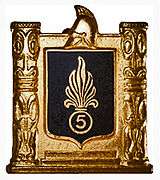
5e R.M.P Type 1 -
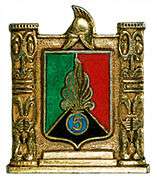
5e R.M.P Type 2 -

5e R.E
Regimental Colors
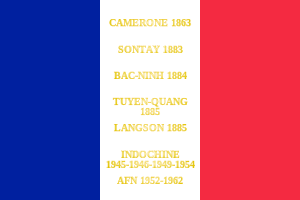
Regimental Song
I
Vaillants guerriers de ce Régiment
Vous qui luttiez si superbement
En maintenant dans la tourmente
L’Honneur et la Fidélité
Vos successeurs ont serré les rangs
Donné leur cœur et versé leur sang
En combattant sans épouvante
Pour le 5e Étranger
Le front haut et l’âme fière
Marchant du pas de nos anciens
Nous suivons dans la poussière
Un glorieux chemin
La boue sombre des rizières
Scella notre destin
Donnant ce nom qui sonne clair
Régiment du TONKIN
II
Toujours plus haut flotte fièrement
Le beau drapeau de ce Régiment
Jetant au vent notre devise
D’Honneur et de Fidélité
Et sans l’écrin des plis glorieux
Tout le TONKIN revit à nos yeux
En le voyant que chacun dise
C’est le 5e Étranger
Decorations
The reigmental colors are decorated with:
- Croix de guerre 1939 1945 with:
- 1 citation at the orders of the armed forces
- croix de guerre des TOE with:
- 2 citations at the orders of the armed forces
- with colors of the croix de guerre des TOE
Honours
Battle Honours
- Camerone 1863
- Sontay 1883
- Bac-Minh 1884
- Tuyen-Quang 1885
- Langson 1885
- Indochine 1945-1946-1949-1954
- AFN 1952-1962
Notable officers & legionnaires
- Chef de bataillon Raoul Magrin-Vernerey - from 1933 to 1937.
- Lieutenant Chenel - from 1941 to 1947.
- Colonel Alessandri - regimental commander 1941.
- Colonel Henri Dufour, commandant 3/5 - 1951-1952 - regimental commander of the 1st Foreign Parachute Regiment 1e REP.
- Colonel Serge Andolenko, officer at foreign status, saint-cyrien promotion RIF
See also
Notes
References
- Mercer, Charles (1964). Legion of Strangers. Holt, Rinehart,and Winston of Canada, Ltd. pp. 283–286.
- McLeave, Hugh (1973). The Damned Die Hard. Saturday Review Press. ISBN 0-8415-0247-1.
- Windrow, Martin (1996). French Foreign Legion 1914-1945. Osprey Publishing. ISBN 1-85532-761-9.
Sources et bibliographies
- Historique du régiment du Tonkin - D'après : l'historique du 5e REI 1883 - 1959, les articles de Georges d'Ossau.
- 5e Étranger - Historique du régiment du Tonkin T 1 - Ed Lavauzelle
- Légionnaires et bâtisseurs, L'Harmattan, 2006 Jean-Paul Mahuault
External links
- 5e RE - History & images of the 5e RE(I)
